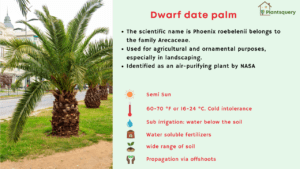Introduction
Dwarf date palm plants are low-height plants having a beautiful crown which made them very popular accent plants in tropical and subtropical landscaping as potted plants. Its elegant shape, size, and hardiness, with easy adaptation to different climatic conditions, make it the most commonly sold dwarf palm species (1). The following article is about dwarf date palm care and the general problems related to this plant.
Dwarf date palm (Phoenix roebelenii) belongs to the family Arecaceae. As we all know the family Arecaceae includes many economically important plants used for agricultural and ornamental purposes, especially in landscaping projects.
Dwarf date palm or pygmy date palm as an air purifier
Another specialty of this dwarf date palm plant is that it is identified as an air-purifying plant by NASA, as it is said to remove formaldehyde and xylene (a chemical found in plastics and solvents) from the air (2)
Botanical description (3)
Height: 6-12 feet
Spread: 6-10 feet
Crown uniformity: irregular outline or silhouette
The shape of the crown: Palm, upright
Crown density: Open
Growth rate: Slow
Texture: Fine
The mature fruits look like small thin fleshed dates and are very much licked by the birds. The structure of the plant is upright or curving. It is a single trunk with a dense full crown. And having alternate leaves odd in arrangement and pinnately compound. The leaflets are in a single plane.
How to take care of Dwarf date palm

Light: Semi-sun
Temperature: 60-70 °F or 16-24 °C. Cold intolerance
Soil type: Adaptable to a wide range of soil. But are not tolerant to salt spray or saline soil.
Indoor potting soil: Use standard indoor potting soil. Sub-irrigation that is giving water below the soil is preferred to frequent watering.
Pest and other problems in Dwarf date palm (4)
1. Potassium deficiency
This deficiency occurs in the oldest leaves. Yellow-orange discoloration of the leaflets and necrosis of the leaf tips happens. To gradually increase the number of leaves in the crown proper fertilization is hence required.
2. Magnesium deficiency
Symptoms of Mg deficiency are similar to those of K deficiency. The only difference is that Mg-deficient leaves a broad yellow band along the outer margin of each leaf occurs. And the center of the leaf sharply transitions to dark green.
No leaf tip necrosis happens in this deficiency. Routine application of the fertilizer will prevent Mg deficiencies and can be used to correct mild to moderate Mg deficiencies.
3. Ganoderma butt rot
This plant is relatively resistant to diseases, but two diseases are fairly common in this species. Ganoderma butt rot, a soil-borne fungal disease caused by Ganoderma zonatum, causes decay in the bottom couple of feet of the trunk. There is no control for this disease.
4. Pestalotiopsis leaf spot
Another common disease, particularly during cooler months, is the Pestalotiopsis leaf spot, which causes necrotic lesions on the leaflets, rachis, and petioles. In severe cases, this disease can kill the palm
5. Mites and insects
Mites and insects such as mealybugs, scales, weevils, and caterpillars may damage the date palm plant.
Note: Young leaves of pygmy date palms are normally covered with a whitish material that is often mistaken for whitefly, mealybug, or scale infestation. This material drops off naturally as the leaves age.

Pingback: Lady palm diseases - Your Gateway to Plants Knowledge